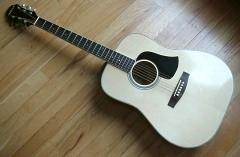Acoustic guitar: Difference between revisions
| Line 46: | Line 46: | ||
==References== |
==References== |
||
| ⚫ | |||
{{Reflist}} |
{{Reflist}} |
||
| ⚫ | |||
==See also== |
==See also== |
||
Revision as of 11:33, 5 December 2008

An acoustic guitar is a guitar that uses only acoustic methods to project the sound produced by its strings. The term is a retronym, coined after the advent of electric guitars, which depend on electronic amplification to make their sound audible.
Sound production
In all types of guitars the sound is produced by the vibration of the strings. However, because the strings can only displace a small amount of air, the volume of the sound needs to be increased in order to be heard. In an acoustic guitar, this is accomplished by using a soundboard and a resonant cavity, the sound box. The body of the guitar is hollow. The vibrating strings drive the soundboard through the bridge, making it vibrate. The soundboard has a larger surface area and thus displaces a larger volume of air, producing a much louder sound than the strings alone.
As the soundboard vibrates, sound waves are produced from both the front and back faces. The sound box provides both a support for the sound board and a resonant cavity and reflector for the sound waves produced on the back face of the soundboard. The air in this cavity resonates with the vibrational modes of the string (see Helmholtz resonance), increasing the volume of the sound again. The back of the guitar will also vibrate to a lesser extent, driven by the air in the cavity. Some sound is ultimately projected through the sound hole[1] (some variants of the acoustic guitar omit this hole, or have holes, like a violin family instrument). This sound mixes with the sound produced by the front face of the soundboard. The resultant sound is a complex mixture of harmonics that give the guitar its distinctive sound.
No amplification actually occurs in this process, in the sense that no energy is externally added to increase the loudness of the sound (as would be the case with an electronic amplifier). All the energy is provided by the plucking of the string. The function of the entire acoustic system is to maximize intensity of sound, but since total energy remains constant, this comes at the expense of decay time. An unamplified guitar (one with no soundboard at all) would have a low volume, but the strings would vibrate much longer, like a tuning fork. This is because a damped harmonic oscillator decays exponentially, with a mean life inversely proportional to the damping. When the strings are driving the larger soundboard and sound box, the damping is much higher.
Amplification

An acoustic guitar can be amplified by using various types of pickups or microphones. The most common type of pickups used for acoustic guitar amplification are piezo and magnetic pickups. Piezo pickups are generally mounted under the bridge saddle of the acoustic guitar and can be plugged into a mixer or amplifier. Magnetic pickups are generally mounted in the sound hole of the acoustic guitar and are very similar to those found in electric guitars.
Instruments with larger areas for the guitar top were introduced by Martin in an attempt to create louder volume levels. The popularity of the larger "dreadnought" body size amongst acoustic performers is related to the greater sound volume produced.
Types
Historical and modern acoustic guitars are extremely varied in their design and construction, far more so than electric guitars. Some of the most important varieties are the classical guitar (nylon-stringed), steel-string acoustic guitar and lap steel guitar. A more complete list is given below, refer to the individual articles for more specific detail.
- Nylon/gut stringed guitars:
- Renaissance guitar
- Baroque guitar
- Romantic guitar
- Classical guitar, the modern version of the original guitar, with nylon strings
- Flamenco guitar
- Steel stringed guitars:
- Steel-string acoustic guitar, also known as western, folk or country guitar
- Twelve string guitar
- Resonator guitar (such as the Dobro)
- Archtop guitar
- Battente guitar
- Lap steel guitar
- Lyre guitar
- Acoustic bass guitar
- Russian guitar
- Novelty instruments:

